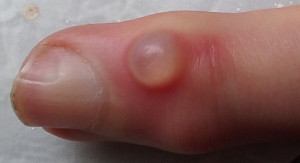Difference Between Pimple And Cyst
 A pimple, acne, or zit is the result of excess oil getting trapped in naturally occurring pores. The skin or the epithelial cells can also get trapped in between the pore and cause blockage. This blockage results in pustule, which is called a zit or a pimple. It commonly occurs in adolescence and in young adulthood. The major causing factors involved are the stimulation of sebaceous gland secretion by androgens, and microbial colonization of sebaceous units by Propionibacterium acnes3, which promotes inflammation near the pores.
A pimple, acne, or zit is the result of excess oil getting trapped in naturally occurring pores. The skin or the epithelial cells can also get trapped in between the pore and cause blockage. This blockage results in pustule, which is called a zit or a pimple. It commonly occurs in adolescence and in young adulthood. The major causing factors involved are the stimulation of sebaceous gland secretion by androgens, and microbial colonization of sebaceous units by Propionibacterium acnes3, which promotes inflammation near the pores.
Clinical features of a pimple
The clinical features of acne include seborrhoea (excess grease), non-inflammatory lesions (open and closed comedones), inflammatory lesions (papules and pustules), and various degrees of scarring. The increased activity of sebaceous glands elicited by androgen causes proliferation of P.acnes, which is an anaerobic bacterium present within the retained sebum in the sebaceous ducts.
Diet, sunlight, and skin hygiene have all been implicated in acne, but little evidence supports or refutes such beliefs. One systematic review suggested that dairy products (especially milk) increase acne risk, but all the included observational studies had significant shortcomings.
Treatments
Topical treatments
Topical treatments only work where applied. Because topical therapies reduce new lesion development they require application to the whole affected areas, rather than individual spots. Benzoyl peroxide: Benzoyl peroxide is a safe and effective over-the-counter preparation that has several mechanisms of action, and should be applied to all the affected area. Topical retinoids: Treatment with tretinoin, adapalene, and isotretinoin require medical prescriptions.
Topical antibiotics
How topical antibiotics improve acne has not been clearly defined, but they seem to act directly on P acnes and reduce inflammation. Topical antibiotics include clindamycin, erythromycin, and tetracycline.
Other topical therapies: Salicylic acid is an exfoliant and is a component of many over-the-counter preparations.
Oral treatments: Oral antibiotics: They are usually reserved for more severe acne, acne predominantly on the trunk, acne unresponsive to topical therapy, and in patients at greater risk of scarring. The use of antibiotics for acne has been questioned owing to resistance concerns. Oral contraceptives: Combined oral contraceptives (COCs) contain an oestrogen (ethinylestradiol) and a progestrogen. COCs are frequently prescribed for women with acne because oestrogen suppresses sebaceous gland activity and decreases the formation of ovarian and adrenal androgens
What is a cyst?
Cyst is an enclosed sac surrounded by a biological membrane, within a tissue.
The cysts can be benign or malignant. Benign cysts can grow in size and interfere with the normal functioning of the organ they grow in. Malignant cysts can be precancerous. Cysts can form from the proliferation of various tissues including epithelial tissue making up the skin, the epithelial cell linings of the blood vessels, and epithelial cells forming the lining of the body cavities amongst other tissues. Sometimes cysts become detached from surrounding structures and travel to the other places in the body through blood and or lymph. The cysts may contain solid liquid and gaseous material. These could be the natural body secretions, or, foreign material. Cysts that are infected may contain bacteria, parasites or other foreign objects.
-
Types of cyst:
Many types of cysts can occur in a human body and are generally named afterthe tissue or organ they occur in. Examples include: Epidermoid (sebaceous) cyst which is a benign swelling in the skin arising in the sebaceous gland, Breast cyst is a fluid-filled sac within the breast, synovial cyst is a non-neoplastic soft-tissue collection that may occur in any joint, ovarian cysts which is an accumulation of fluid within or on the surface of an ovary etc. Small cysts may have no symptoms or signs but some cysts can be felt as a lump or bump in the skin or even in the tissues beneath the skin. Sometimes these cysts are painful. Treatment:
If the cysts become large and displace or compress other organs or block normal fluid flows in tissues like the liver, pancreas, or other organs, then symptoms related to those organs may develop. Cyst can be treated by compression or aspiration and removal of fluid using a needle, and larger cyst can be removed using surgical excision.
How is a cyst and acne different?
- Cysts are sacs surrounded by biological membrane, whereas, acne is an abscess. Cystic acne is severe case of acne and is not actually cysts. It manifests as severe inflammation with appearance of nodules and can result in scarring. Most forms of acne do not produce physical symptoms felt by the person himself or herself, but the skin’s appearance can cause emotional distress. In cystic acne2, however, the distress may be higher as compared to other acne and the cysts may be painful.
- Difference Between Pimple And Cyst - June 21, 2016
- Difference Between Holding And Dictum - June 20, 2016
Search DifferenceBetween.net :
Leave a Response
References :
[0]Magin, P., Pond, D., Smith, W., & Watson, A. (2005). A systematic review of the evidence for ‘myths and misconceptions’ in acne management: diet, face-washing and sunlight. Family Practice, 22(1), 62-70.
[1]Thiboutot, D. M. (1996). An overview of acne and its treatment.Cutis, 57 (1 Suppl), 8-12.
[2]Toyoda, M., & Morohashi, M. (2001). Pathogenesis of acne.Medical Electron Microscopy, 34(1), 29-40.
[3]Williams, H. C., Dellavalle, R. P., & Garner, S. (2012). Acne vulgaris. The Lancet, 379 (9813), 361-372.
[4]https://www.flickr.com/photos/upsand/15462466203
